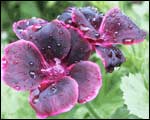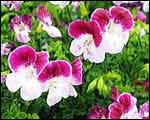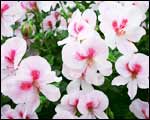Good-looking geraniumsWith over 300 species of annual, biennial and perennial geraniums, there's bound to be one that suits your garden.
Most of what we commonly call geraniums are actually pelargoniums, but few gardeners are worried about this minor technicality — they're too busy enjoying the plants! Where to grow geraniums
Geraniums are often at their best in containers. Growing geraniums in pots guarantees drainage and also gets the plants up and away from the ground where they're less likely to be attacked by fungal diseases. Well-drained pots (like Yates Tuscans, with their copious drainage holes) are a must. Propagation
Fertilising Geraniums do best if they're not given too much nitrogen-rich fertiliser (which tends to cause soft, leafy growth rather than flowering). Instead, from spring through till autumn, feed the plants regularly with Thrive Flower & Fruit, which has a balance of nutrients that encourages flower production and disease resistance. Pests and diseases
Botrytis, or grey mould, can also spoil the flowers if the weather is wet for any length of time. Affected flowers grow fluffy, grey beards before turning brown and shrivelling up. Pluck off the affected flowers and try to keep the above-ground parts of the plant as dry as possible. Spray with Bravo or Greenguard.
|
Home | Journal
| Newsletter | Conferences
Awards | Join
RNZIH | RNZIH Directory | Links
© 2000–2024 Royal New Zealand Institute of Horticulture
Last updated: March 1, 2021


 Geraniums
bring the brightest of colours to the garden and they are among
the most generous of plants. They flower for month after month and
then, when they begin to look tired, a cut back and feed starts
them off all over again.
Geraniums
bring the brightest of colours to the garden and they are among
the most generous of plants. They flower for month after month and
then, when they begin to look tired, a cut back and feed starts
them off all over again.  An
open, airy situation with plenty of sun is ideal for geraniums.
This helps the plants in two ways. First, the sun promotes and encourages
plenty of flowering. As well, a light, open position helps the plants
to stay free from disease.
An
open, airy situation with plenty of sun is ideal for geraniums.
This helps the plants in two ways. First, the sun promotes and encourages
plenty of flowering. As well, a light, open position helps the plants
to stay free from disease.  Garden
geraniums are renowned for their ease of propagation. Simply snap
off a piece about 10 cm long and put it into a pot filled with Yates
Black Magic Seed Raising Mix. Wait a few weeks and you'll have a
new plant.
Garden
geraniums are renowned for their ease of propagation. Simply snap
off a piece about 10 cm long and put it into a pot filled with Yates
Black Magic Seed Raising Mix. Wait a few weeks and you'll have a
new plant.  The
most common disease found on geraniums is rust, so-named because
of the rust-like bumps that appear on the leaves. Rust control used
to be put into the 'almost-too-hard' basket, but, since the introduction
of Baycor, effective control is now possible. Baycor works from
within the leaf and can cure existing disease as well as helping
to prevent new disease from taking hold.
The
most common disease found on geraniums is rust, so-named because
of the rust-like bumps that appear on the leaves. Rust control used
to be put into the 'almost-too-hard' basket, but, since the introduction
of Baycor, effective control is now possible. Baycor works from
within the leaf and can cure existing disease as well as helping
to prevent new disease from taking hold.  Whitefly
is an insect pest that is found in vast colonies on certain types
of geraniums. Spray with Yates Nature's Way Pyrethrum, talking care
to apply it under the leaves as well as on top. Pyrethrum will also
help to get rid of any caterpillars that might be thinking about
attacking your geranium plant.
Whitefly
is an insect pest that is found in vast colonies on certain types
of geraniums. Spray with Yates Nature's Way Pyrethrum, talking care
to apply it under the leaves as well as on top. Pyrethrum will also
help to get rid of any caterpillars that might be thinking about
attacking your geranium plant.